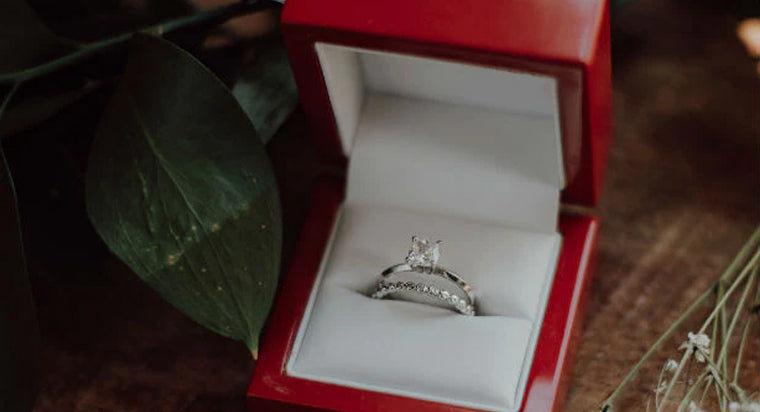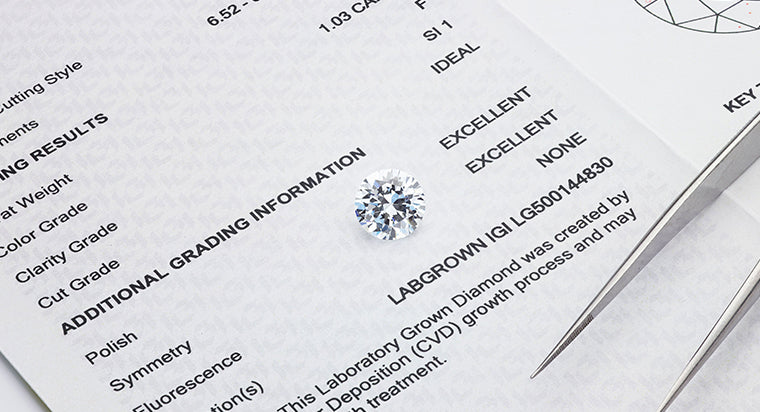Diamond Fluorescence
Diamond fluorescence is often the most misunderstood diamond attribute. Fluorescence is simply the diamond's reaction to UV light (black light). Diamonds with fluorescence will glow or radiate a blue color in the UV environment. Most commonly diamonds radiate a blue color but in certain instances this glow can also be white, yellow, green or even red. Fluorescence can be found in about 30% of all gem quality diamonds. It comes from the inclusion of trace elements naturally contained within a diamond during the carbon crystallization process. There is no material evidence for what exactly causes fluorescence. GIA has conducted fluorescence studies in which they found little to no evidence that fluorescence had a visual impact on the diamond's appearance.
It is important to understand that the structural integrity of a diamond is not affected by fluorescence. The presence of natural elements in the diamond that cause fluorescence do not weaken the binding of hardened carbon.
TABLE OF CONTENTS
Fluorescence Grading
Diamond fluorescence is graded on a scale established by GIA. Please note that fluorescence seems to visually impact the diamond in about 1% or less of all cases. To reduce the possibility, With Clarity does not carry Very Strong fluorescence graded diamonds. Of all the diamonds submitted to GIA for grading, approximately 25% to 35% show some fluorescence. Less than 1% of fluorescent diamond may affect the appearance due to medium, strong or very strong fluorescence.
Fluorescence is predominantly blue in glow. At times, you may find diamonds with yellow, white or red fluorescence. This is very rare and can have essentially the same impact on the diamond as a blue fluorescent diamond.

None
No soft, blue glow is emitted when the diamond is exposed to UV light. The diamond has no trace elements that cause fluorescence. None fluorescence has the largest premium and is highly desired and expensive.

Faint
A slight soft, blow glow is noticed when the diamond is exposed to UV light. The diamond has minor trace elements that cause fluorescence. There is no impact on the diamond. None and Faint fluorescence have an almost identical effect on a diamond's value.

Medium
A light blue glow is emitted by a diamond, when exposed to UV light. Medium fluorescence offers an excellent value as it reduces diamond price. It can improve the color of lower grades such as J, K or L.

Strong
A deep, blue glow is emitted by the diamond when exposed to UV light. Diamonds with Strong fluorescence can slightly improve lower colors such as J, K or L. Conversely, it can have a negative effect on high color diamonds such as D, E, which can look slightly grayish or hazy.

Very Strong
A very bright blue glow is present when the diamond is exposed to UV light. The diamond's appearance may be effected. Very Strong fluorescence can make a diamond look gray or hazy.
Effect on Sparkle and Price
Fluorescence seldom has any effect on a diamond's sparkle. It is generally recommended though that consumers avoid fluorescence in high colors such as D, E or F. It is actually recommended to consider fluorescent diamonds in I, J, K or L colors. The lower colors may visually appear half or one grade higher as a result of the fluorescence. More important fluorescent diamonds have about a 10% to 15% discount against Faint or None fluorescent diamonds. That means great value and major savings. Fluorescence very rarely affects a diamond in any visual way. GIA simply measures it for transparency purposes. In fact in 1997, a study conducted by GIA showed that fluorescence does not have a significant impact on the appearance of the diamond. Therefore, this characteristic should not be a major deciding factor when choosing a diamond.
Typically, the most difficult decision in selecting a diamond, with regards to fluorescence, if whether to choose None or Faint and Medium or Strong. The short answer to either of these questions is that it frankly doesn't matter. The difference and affect on the diamond's sparkle is virtually undetectable. Then whether the question is None or Faint or if it's Medium or Strong, go with whichever offers you the best value.
Is Fluorescence Good or Bad?
Before we answer this question in detail, get a crash-course on diamond fluorescence from our co-founder.
GIA has extensively studied the concepts of fluorescence and whether it impacts the visual appearance of a diamond. After years of testing, they found that there is no material effect on the sparkle or visibility. Here's their diamond fluorescence study. Our experience as gemologists tells us that this is mostly true, except in maybe less than 1-2% of instances where it has an impact, whether positive or negative.
Here's an example of how the diamond's beauty is enhanced: In colors with a warm yellow tint such as J - L, strong or medium fluorescence can at times make the diamond appear whiter and remove some of the faint yellow tint. Keep in mind the difference is very minor, so it will not make a J color diamond look like a D, E or F color. When a diamond is one of those higher colors though, the extra whitening effect can adversely affect the diamond, again in a very small number of cases.
At times, diamonds with Very Strong Blue fluorescence can reveal an oily, milky, hazy or grayish look. It can dull or darken the diamond in a strange way. For this reason, With Clarity doesn't carry Very Strong Blue diamonds. You typically never need to worry about this in the other grades: "none", "faint", medium". For Strong Blue diamonds, simply contact a With Clarity gemologist and we'll tell you more about the particular stone.
Finally, it's important to note that fluorescence in no way affects the structural integrity or strength of the diamond. It's essentially a diamond side effect, but nothing more.
FAQs
What is fluorescence in a diamond?
Is faint fluorescence in a diamond bad?
Can lab diamonds have fluorescence?
How to check fluorescence in a diamond?







